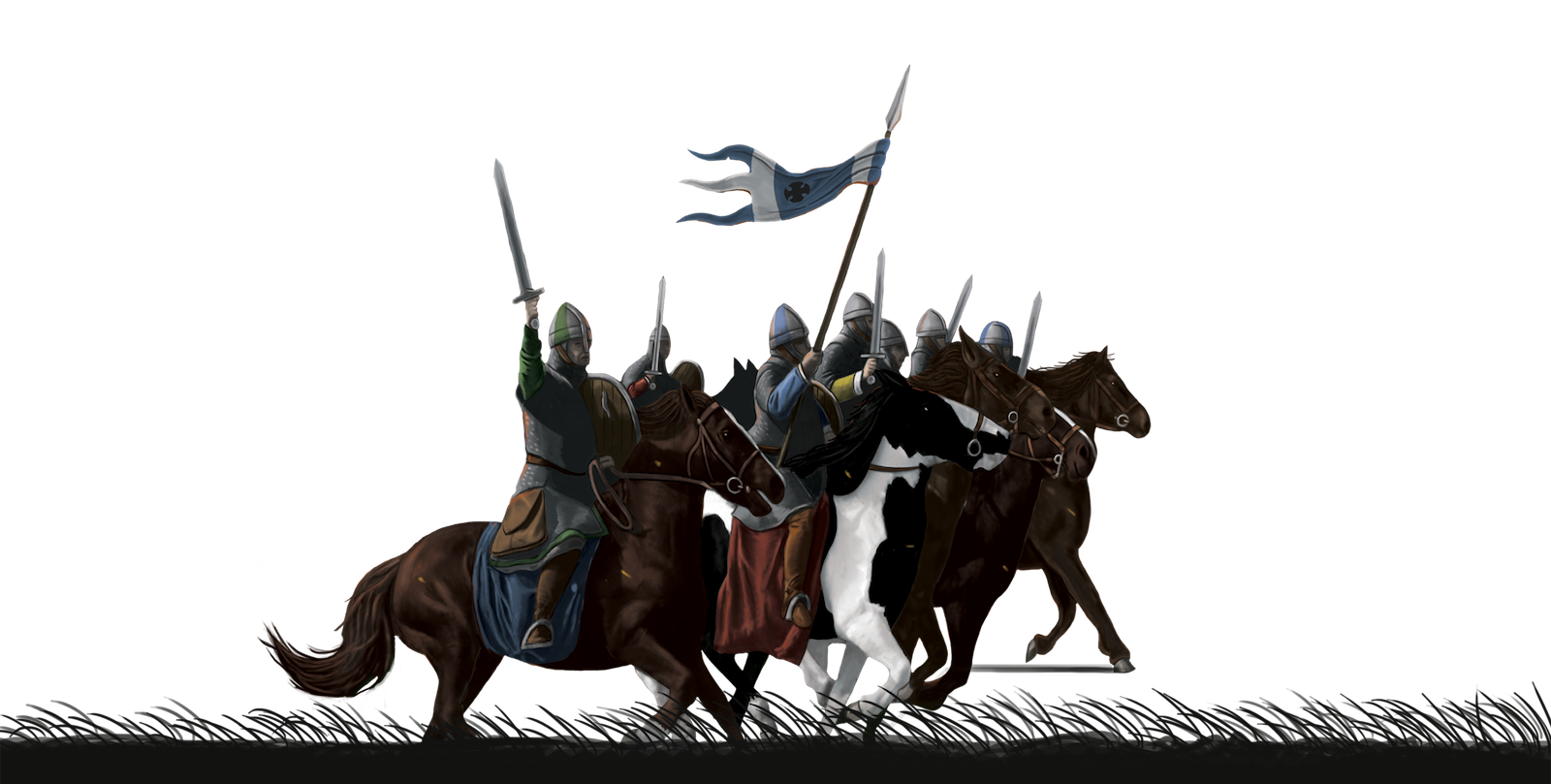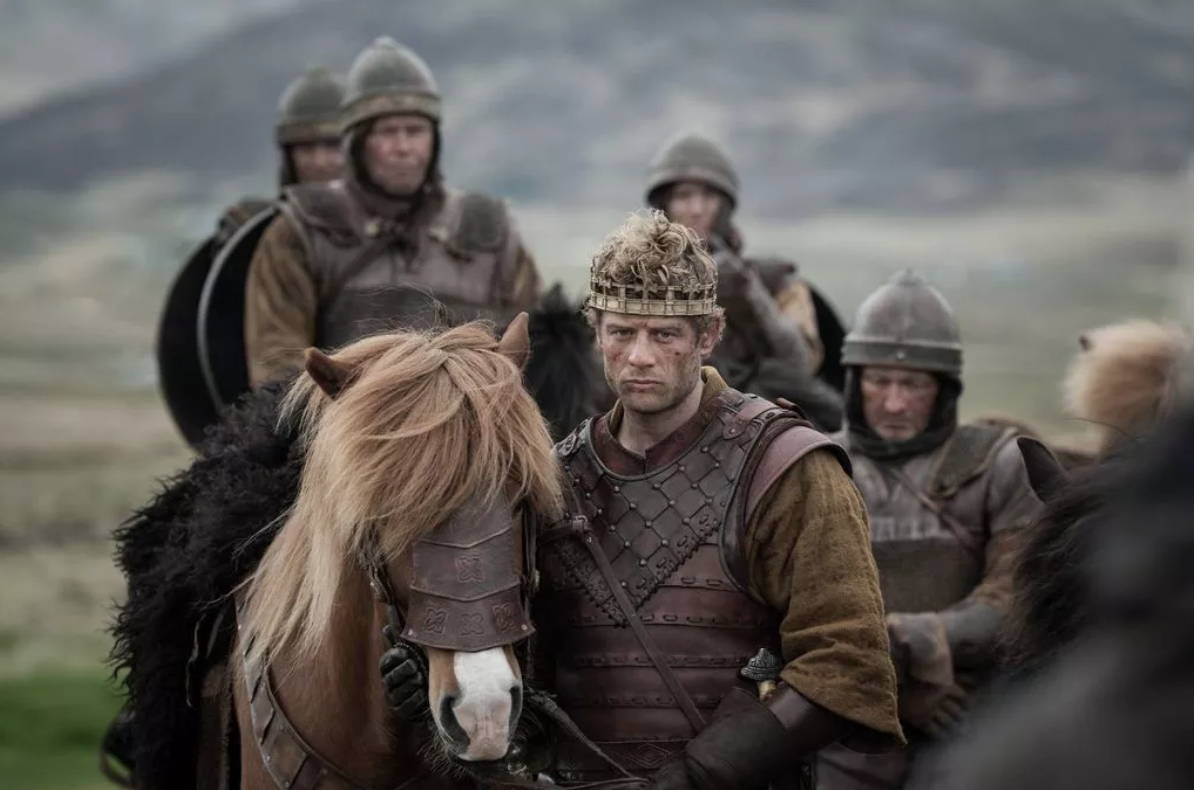
Two kings and a conqueror – Edward, Harold and William
21 Aug 2025
New BBC epic coming soon
The image heading this blog (Source: Lilja Jons) is from a trailer for a new historical epic King and Conqueror starting on the BBC on 24th August. It features the competing claims of Harold Godwinson and William of Normandy for England’s crown, that led up to the Battle of Hastings in 1066. It’s the period I cover in my novel series The Book and the Knife, so I’m intrigued to see how Harold and William will be portrayed.
With Harold played by James Norton and William by Nikolaj Coster-Waldau, it promises to be an absorbing tale. As well as the two protagonists, there’s a host of larger than life minor characters to throw into the mix. All this takes place over many years before the bloody day at Hastings, which of course was actually at Battle, which of course was not called Battle then.
The actual location of the battle site, the formations and strengths of the opposing armies and what happened during the day would fill a blog on its own. For now I’ll say that the Normans referred to the site as ‘Senlac’ which may be a corruption of the local place name Sandlake. So in The Book and the Knife I have the Normans call it Senlac and the English Sandlake.
Three characters in search of an author
The BBC King and Conqueror title is a bit misleading, as Harold was only king for 10 months in 1066, and William only became the ‘conqueror’ on the 14th of October of that year when he triumphed in the battle. A lot happened in the 11th century before then, when Harold was a mere earl and William a mere duke. In fact, much of the story revolved around another king – Edward of Wessex, who ruled from 1043 until his death in early 1066.
William, Harold and Edward all feature right from the early pages of Thegn of Berewic, Part One of The Book and the Knife. All three will one day become kings of England – but what links them, and what are the character traits they show that will lead to the disaster for England on the battlefield in 1066?
Edward of Wessex
Edward was the eldest son of Ethelred of the House of Wessex, the last English king before the Danes took over in 1016 on Ethelred’s death, and his wife Emma, who was William of Normandy’s grandfather’s sister, so he and William were second cousins. Edward’s link to the Godwin family was not through blood, but after he became king, he married Harold’s sister Edith.
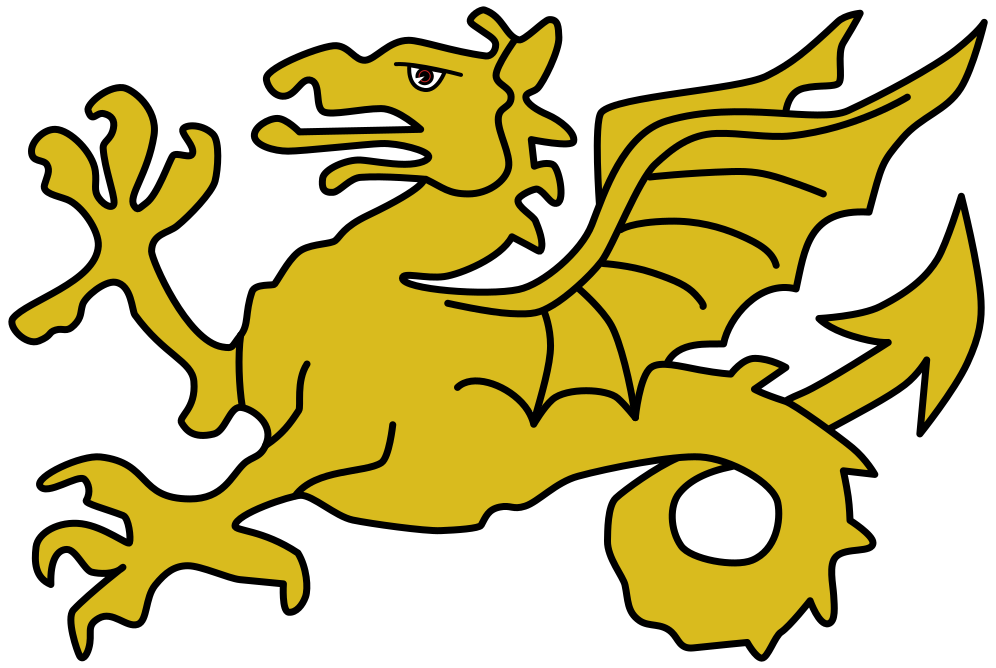
The Wessex wyvern Source: Wikipedia
Edward lived for 25 years in Normandy, and in my novel he is far from the pious milksop he was painted to be later. (This was largely an invention of Edith’s who was anxious to explain why she and Edward had remained childless, and to paint her family the Godwins in the best possible light for posterity.) A lover of hunting and of hunting dogs, reportedly with a quick temper, it’s hard to imagine a young man like Edward, growing up abroad without the duties of a future king to burden him, not enjoying pleasures of all kinds… In fact, in Thegn of Berewic I depict Alfred as the more godly and unworldly of the two brothers, and he loves The Book.
Wait a minute… Edward is a king’s son, but has no prospect of taking the crown? Because when the Danes defeated the English and Cnut became king, the newly widowed Emma married Cnut. How’s that for switching sides? So Edward and Alfred fled to exile in Normandy, supported by the Norman dukes, and hoping they were out of the reach of Cnut’s assassins. In Thegn of Berewic Rædmund, a thegn of a branch of the House of Wessex, goes with his family and the two royal princes to Normandy while Cnut gives his manor to a thegn of a branch of the Godwins, Sighere. That manor is Berewic…
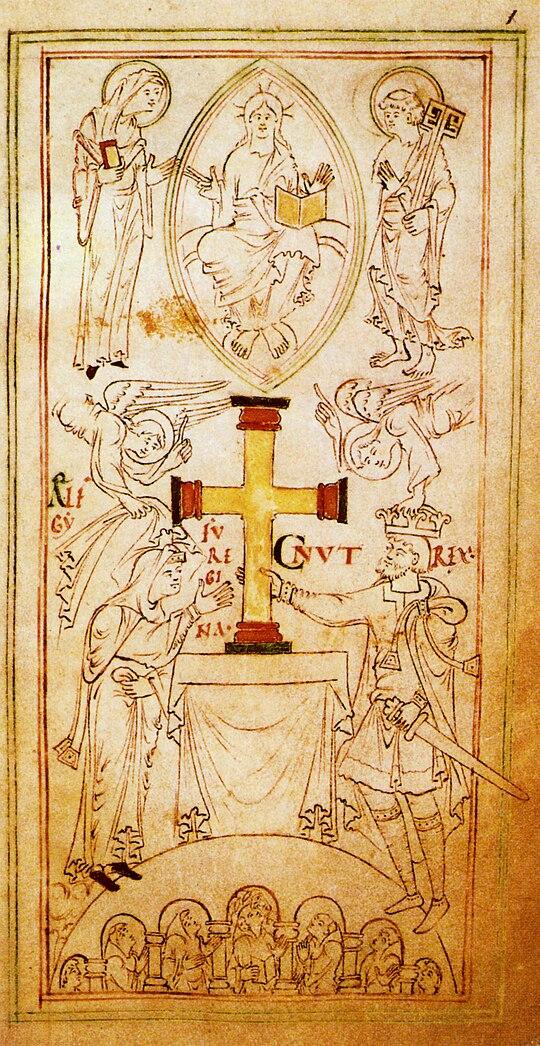
Cnut and Emma gifting a cross to Winchester cathedral Source: Wikipedia
To rub salt into the English wounds, Emma bore Cnut a son, Harthacnut, who she then supported against Edward’s claim to the throne after Cnut died. Emma was a devious political operator who continued to agitate against Edward even after he became king, yet we must remember that as a woman she had to operate in a man’s world. If she wielded any power, as she puts it in Thegn of Berewic, it was ‘the power the powerless find for themselves, when men give them no choice’.
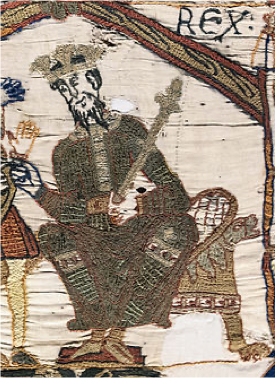
Edward depicted in the Bayeux Tapestry Source: Wikipedia
When he eventually returns to become king, Edward is constantly at odds with the Godwins, England’s ambitious kingmaker family who under Cnut rose from obscure origins to hold the chief earldoms of the land (including rather confusingly, the earldom of Wessex!). Edward and Edith remain childless, and a promise by Edward to William of England’s throne is taken by the Norman duke as absolutely binding. He would rather die than give up his claim, and he knew at the Battle of Hastings that on that day either he or Harold must fall. It was an all or nothing gamble, and William won.
William of Normandy
So what is the William of The Book and the Knife like? I depict him as utterly loyal to those who support him and ruthless to those who oppose him, as well as a wily and clever tactician, and I think both of those are pretty close to the real William. You’ll have to wait until the third and fourth novels of the series, Outlaw of the Conquest and The True King, to find out what he is really capable of, but there are plenty of clues in Thegn of Berewic.
When my character Samra goes to see her friend Miriam in Rouen, Samra says she cannot believe William would harm her. Miriam responds with a story of the duke’s recent exploits.
‘Let me tell you what harm this duke is capable of.’ Samra looked at her friend and saw that her eyes were full of distress. ‘You have heard of his triumph at Alençon?’ Miriam went on. Samra nodded. ‘When he reached Alençon, it was dawn. The gates of the town were closed to him, of course, and he turned to the fortress. As he began his siege of it, the defenders shouted insults from the walls at him. Then they beat on the hides that protect the tops of the towers, and called him a pelterer.’
Samra frowned. ‘I don’t understand. Why would they call him that?’
‘His mother’s family, who had been undertakers in Falaise, would have worked with animal skins. Some say – though few dare say it – they may even have been Jews. At any rate, the slur on the duke was great. He said nothing, but had his men mount the siege twice as quickly. The fortress soon fell to them, and William ordered that thirty-two of the defenders be taken in front of the town gates. As the townsfolk watched from the walls, the hands and feet of these men were cut off. Alençon surrendered at once. This is your beloved duke.’
As to William’s sense of loyalty, when another of my characters, a young man of the House of Wessex, is sent to serve him in Normandy, William forms an intense friendship with him, and feels intense betrayal when this man deserts him. He shares Edward’s love of hunting and sends my character Gilbert who is his forest warden to the Forest of Valognes to give it a makeover. William sees The Book as a threat to his simple piety and to the church he espouses and uses as an ally to his ambition, and he wants to find and destroy it.
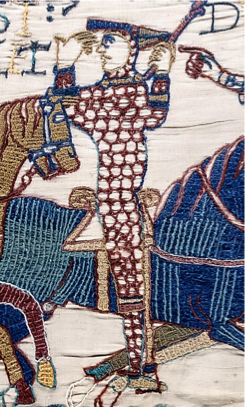
William depicted showing his men he is alive in the Bayeux Tapestry Source: Wikipedia
Harold Godwinson
The large Godwin family that Harold is part of, with their stronghold at Bosham in Sussex, is known as much for its miscreants and hotheads such as Swein and Tostig as it is for its characters like Edith, virtuous and well-educated. Even by the standards of the time, Swein was dreadful PR for the family, abducting the abbess of Leominster (who may have borne him a child), and later murdering his own cousin Beorn at Bosham, being exiled on both occasions. Cruel and tax-greedy, Tostig was loathed as Earl of Northumbria, and when a local uprising outlawed him, Harold felt obliged to support the rebels against his brother, and Tostig was deposed, going into exile in Flanders.
Harold at Bosham depicted in the Bayeux Tapestry Source: Wikipedia
Edward was furious at the spat in his own kingdom, while the brothers’ sister Edith was bitter at the treatment of Tostig and never forgave Harold. Tostig carried his own bitterness into exile and returned to lead raids along the south coast before fatefully persuading King Hardrada of Norway into a joint venture against the English. Discuss: if Tostig and Harold had not fallen out, might Hardrada never have invaded or with a lesser force that would have been defeated in the first battle? Then Harold does not have to come north, and waits in the south to repel William’s fleet when it comes. Ah, fate!
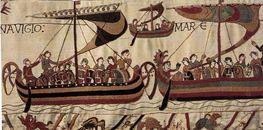
Ships of William’s fleet depicted in the Bayeux Tapestry Source: Wikipedia
Yet Harold was an able statesman and soldier who served Edward well, and was instrumental in defeating the Welsh, always a thorn in England’s side. When the Welsh leader Gruffudd ap Llywelyn is deposed by his own people, and his head sent to Harold, he passes the gift on to King Edward – nice! And an opportunity for one of my characters in the second novel in the series, England’s Ætheling, to deliver it to Edward, with disastrous results.
Harold must have been horribly conflicted by the Tostig affair, making a decision in the best interests of England as he saw it, which needed to have its earldoms united in the face of the threat from Normandy. In Thegn of Berewic, like many in England he also feels betrayed by Edward’s appointment of Normans to his court and church, and dismayed that his country’s throne is promised to William. And Edward has pledged the Norman duke two hostages against his claim – Harold’s own brother Wulfnoth, and Hakon his nephew. I depict Harold as an honourable man who will be spurred by one of my female characters Æadgytha (who is his Godwin cousin) to become – as she puts it – ‘a man of destiny’ for England’s sake.
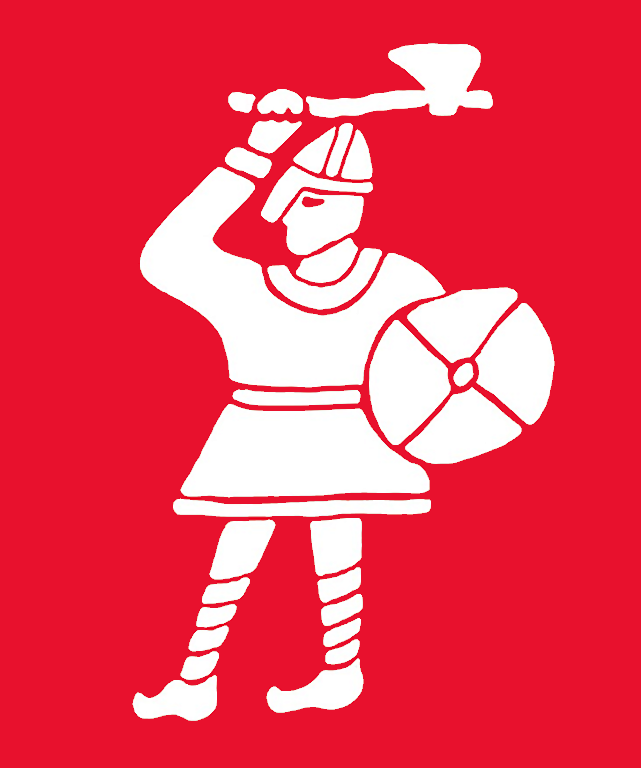
Harold’s banner ‘the armed man’ Source: Wikipedia
The promise of the throne to William was made in a brief period when Edward exiled the Godwins, and when they return in triumph to drive out the Normans Edward brought over with him, the hostages who are Harold’s relatives are whisked away to become William’s prisoners. The stage is set for the events in the following novel England’s Ætheling, with Harold’s disastrous venture to Normandy to attempt to recover them, his own oath made there to William, and his taking of the English throne on Edward’s death in early 1066 that leads to the Norman invasion.
In my novel, in Normandy Harold gets to see how the Normans fight and is admired by William for his own skills in arms, but is outwitted by him in a clever game of faux comradeship, while one of my characters who is acting as his interpreter has left the room. When William does come to England with his army, like him Harold knows at the Battle of Hastings that the winner will take all, and he is prepared to die. At the close of a day-long conflict of savage intensity on the 14th of October, it is Harold who falls. And The Book, and The Knife with the foretelling on its blade, are in peril.
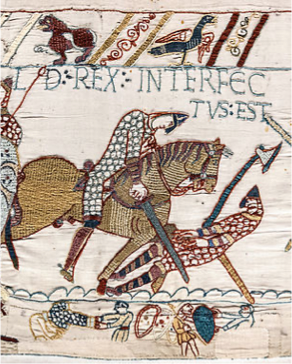
Harold depicted at his death in the Bayeux Tapestry Source: Wikipedia
You can binge-watch King and Conqueror from 6 am on Sunday August 24th on BBC iPlayer, and the first episode airs on BBC One later that evening. Get in touch through my contacts page with any comments you have on it!
